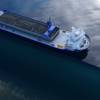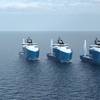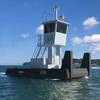MTU Powers Ice-Capable Research Vessel
MTU, a Rolls-Royce brand, was chosen to power the Sikuliaq, a U.S. academic research vessel tailor-made for oceanographic research. The Sikuliaq, one of the most advanced university research vessels in the world, is owned by the National Science Foundation (NSF) and operated by the University of Alaska Fairbanks as a part of the University-National Oceanographic Laboratory System’s academic research fleet.
The Sikuliaq is powered by a total of four MTU Series 4000 Ironmen engines, two of which are MTU 16V 4000 M23S marine generator engines. The remaining two are MTU 12V 4000 M23S marine generator engines. These four continuous rated diesel engines provide on-board power generation for all ship systems and electric propulsion motors. Additionally, an MTU Series 60 marine generator set stands ready to supply emergency power.
The 261-foot double-hulled vessel will be stationed at Seward Marine Center, its homeport in Seward, Alaska, where it will be tasked with year-round operation. The Sikuliaq is the first vessel in the U.S. academic research fleet capable of breaking ice up to 2.5 feet thick, making it uniquely equipped for polar and sub-polar research.
“The Series 4000 engine was chosen for the Sikuliaq as it delivers low fuel consumption, low heat rejection and low noise levels which is essential on research vessel application,” said Andrew Boyer, marine sales manager, MTU America Inc. “Being selected to power the world’s most advanced academic research vessel further solidifies MTU’s ability to meet the most demanding operational criteria in the marine industry.”
Construction on the Sikuliaq began in December 2009 after 36 years of development and vessel design research. The University of Alaska Fairbanks took delivery of the vessel on June 6, 2014 and the Sikuliaq’s first research project began in October off the coast of Honolulu. The vessel accommodates up to 26 researchers, including those with disabilities, who will use the ship to conduct multi-disciplinary studies. Sikuliaq will take researchers to unexplored areas to collect sediment samples directly from the sea floor and map the ocean floor and currents utilizing its advanced research instrumentation. The vessel will also host remotely operated vehicles and will have the capability to transmit real-time information directly to classrooms all over the world.
“Previously, Arctic oceanographers had to employ U.S. or Canadian Coast Guard icebreakers to gain access to the frozen frontier,” said Dan Oliver, director of University Alaska Fairbanks Seward Marine Center. “The long-awaited Sikuliaq marks a new era in artic oceanographic research and it is our privilege to play such a significant role in helping researchers from around the world make scientific breakthroughs.”
MTU’s Series 4000 engines offer unrivaled power density in terms of volume-to power and power-to-weight ratio. Engineered for a low operating noise level and designed to offer superior performance, the Series 4000's advanced technology ensures security at sea with exceptional fuel efficiency and reliability compared to other engines in its class.
The vessel’s four Series 4000 engines were built into marine generator packages by Midwest-based MTU distributor, Inland Power Group. Inland Power Group has provided its customers with expert power advice and support for over 50 years. Each of its six state-of-the-art facilities features its own sales, parts and service departments.
“Like all research vessels, the Sikuliaq aims to make the lowest possible impact on the environment,” said Craig Jarosinski, sales engineering manager at Inland Power Group. “Working side-by-side with The Glosten Associates, the vessel’s marine architecture and engineering firm, we selected the best possible marine propulsion configuration to achieve maximum performance and reliability with the lowest environmental impact.”













